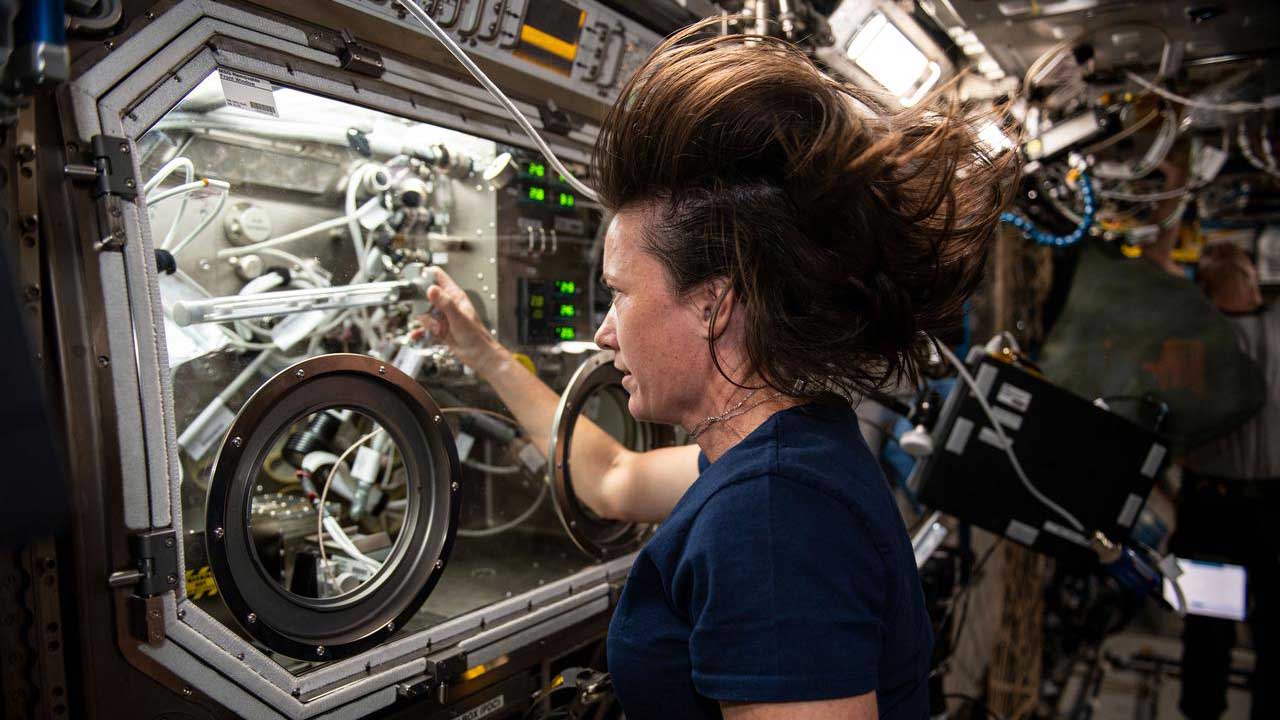Why the U.S. Must Lead the Next Semiconductor Revolution—From Space

NASA astronaut Megan McArthur swapping samples for a space physics study that has the potential for improved technology used in producing semiconductor crystals.
Media Credit: NASA
By Rose M. Hernandez, Science Program Director of Advanced Materials and Manufacturing
July 9, 2025
This piece is part of our Forging the Path series in which CASIS® experts and partners share knowledge and insight on managing a national lab in space.
Rose Hernandez, Ph.D., is Program Director for In-Space Production of Advanced Materials and Manufacturing at the ISSInternational Space Station National Laboratory®, managed by CASIS(Abbreviation: CASIS™) The nonprofit organization that manages the ISS National Lab, which receives at least 50 percent of the U.S. research allocation on the International Space Station to facilitate research that benefits humanity (NASA manages the other 50% and focuses on research for space exploration purposes).® in partnership with NASANational Aeronautics and Space Administration. With more than 28 years of experience in research, innovation, and technology transfer across government, industry, and academia, she works with an exceptional team to advance R&D in LEO for the benefit of humanity.

Technological sovereignty is national security. In today’s world, the ability to design, produce, and secure critical technologies determines a nation’s power, resilience, and independence. The story of the U.S.’s technological sovereignty is, in many ways, the roadmap of semiconductor technologies. Driven by Cold War and “space race” urgency, U.S. investment led to the invention of the integrated circuit (IC) and CMOS (complementary metal-oxide-semiconductor) technology in the late 1950s and early 1960s, enabling low-power, high-density electronics. What followed was nothing short of transformational—from the earliest computers to today’s advanced defense systems, cyber infrastructure, healthcare, and biotech, every sector that protects, sustains, and improves life now relies on computing power.
As the world moves toward an era beyond the limitations of CMOS, microgravityThe condition of perceived weightlessness created when an object is in free fall, for example when an object is in orbital motion. Microgravity alters many observable phenomena within the physical and life sciences, allowing scientists to study things in ways not possible on Earth. The International Space Station provides access to a persistent microgravity environment. manufacturing is emerging as a critical enabler for new computing paradigms—like quantum computing, which leverages principles from quantum mechanics, and neuromorphic computing, which mimics the structure and function of the human brain. To advance this frontier, the U.S. must again lead the way. This time, the next great leap is beyond Earth.
Semiconductors first emerged in the U.S. as a pivotal national security asset. In 1947, William Shockley, alongside John Bardeen and Walter Brattain, invented the transistor in the cleanrooms of Bell Labs. Later, the invention of the IC by American pioneers like Jack Kilby and Robert Noyce enabled the miniaturization of computing, leading to our technological superiority over geopolitical adversaries. These inventions revolutionized electronics and laid the groundwork for the modern semiconductor industry.
By 1969, the Apollo Guidance Computer, which helped land humans on the Moon, was one of the first major uses of ICs in a mission-critical system. It was at that point that ICs began shifting from defense and aerospace into commercial applications (mainframes, calculators, and early digital systems). From powering Apollo to enabling advanced communication and imaging systems, semiconductor technology has driven nearly every leap in science and security. This success was no accident—it was the result of a cohesive national vision that united industry, academia, and government around innovation for security and prosperity.
Over the past six decades, this commitment has kept the U.S. at the forefront of critical technologies. However, the landscape of technological leadership is changing. Terrestrial fabrication of ICs is approaching fundamental physical and economic limits, while demand for more powerful, energy-efficient, and radiation-hardened chips is growing exponentially. To maintain its edge, the U.S. must embrace a frontier that it has already helped establish: space-based semiconductor research and development (R&D).
The microgravity conditions in low Earth orbit(Abbreviation: LEO) The orbit around the Earth that extends up to an altitude of 2,000 km (1,200 miles) from Earth’s surface. The International Space Station’s orbit is in LEO, at an altitude of approximately 250 miles. (LEO) offer a radically different environment for semiconductor R&D. Reduced gravitational forces enable more uniform crystal growth, resulting in semiconductor crystals with lower defect densities and unique atomic arrangements. Quantum materials behave in new ways, enabling architectures that are extremely difficult, if not impossible, to reproduce on Earth. Since the 1980s, U.S. scientists have studied these effects. By the early 2000s, structured semiconductor research was underway on space shuttle missions and, later, on the International Space Station (ISS).
Since then, the ISS has become a critical platform for advancing next-generation computing materials like semiconductors. In 2011, the Center for the Advancement of Science in Space® (CASIS®) was established to manage the ISS National Laboratory®, explicitly setting a vision to advance R&D in areas that serve both commercial and national interests, including semiconductors and quantum materials. With support from NASA, CASIS has enabled government, academic, and industry researchers to explore microgravity’s impact on crystal growth, thin-film deposition, and quantum entanglement properties.
This effort goes beyond scientific exploration; it directly supports economic competitiveness and national resilience. Our most advanced systems, autonomous platforms, secure communications, and next-generation sensors depend on the performance and precision of microelectronics. As space manufacturing capabilities grow worldwide, the U.S. plays a key role in advancing materials and device innovation.
Just as the launch of Sputnik in 1957 catalyzed the U.S. to reach the Moon in 1969, today’s global shifts must catalyze a new “space race,” not just to explore space but to manufacture the future within it. Nations like China have identified space-based semiconductor manufacturing as a strategic priority and are advancing efforts in this domain. This time, the U.S. is helping shape the future of in-space manufacturing of semiconductors by driving innovation through strategic investments and research. Continuing this momentum will be critical to long-term leadership in the field. This includes a coordinated national effort to invest in orbital R&D infrastructure, support public-private partnerships, and sustain platforms like the ISS and its successors.
Looking ahead to the next 50 years, space-based semiconductors are likely to play a critical role in national security. The good news is we are not starting from scratch. Programs through NASA, the Defense Advanced Research Projects Agency (DARPA), the U.S. National Science Foundation, and the CHIPS and Science Act are laying the groundwork for commercial and national applications of in-space manufacturing. These initiatives must be scaled and accelerated. We must treat microgravity as more than a research setting—it is an extension of the innovation ecosystem that has always set the U.S. apart.
The U.S. has the scientific depth, commercial infrastructure, and historical momentum to lead once again. What we need now is sustained focus and strategic coordination. The cost of delay is not just a missed opportunity; it will be a dangerous vulnerability.
Just as we could not have predicted in 1969 that the same integrated circuits used in the Apollo Guidance Computer would someday power every phone, car, and satellite, we cannot yet predict the full impact of microgravity-enabled semiconductors. As inventor Shockley once famously said, “We knew we had a new world by the tail.” Today, with breakthroughs in space-enabled manufacturing and post-CMOS computing on the horizon, we have a new world by the tail once again.
We the people who are shaping the foundation for computing technologies and manufacturing in space will shape the future of our global security and prosperity. Let’s lead in-space manufacturing of semiconductors like it is 1969.